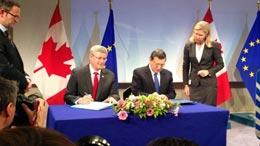Free trade deals showcase Canada's domestic dysfunction

Guest Commentary
By Laura Jones
It is an embarrassing state of affairs when many small businesses report that North-South trade with the U.S. is easier than East-West trade within Canada.
But this is nothing new. It was such a big concern when the North American Free Trade Agreement was coming into force more than two decades ago that the provinces put in place the Agreement on Internal Trade. Unfortunately, that agreement has been a colossal failure.
Fast forward to today and the prospects of a trade deal with Europe is shining a spotlight on our domestic dysfunction. Do we want it to be easier for Canadian businesses to trade with other countries than other provinces? Well, of course not. But the big question on everyone’s mind is whether Canada’s provincial and federal governments can deliver a better outcome than last time around.
There are some reasons for optimism. On the premiers’ direction, Canada’s trade ministers met for the first time in four years earlier this week to work toward a March 2016 deadline to have a new agreement in place. As part of a business coalition, I presented to the group. The thing that struck me most was the non-partisan environment in the room. Politicians of all stripes seem serious about working together for the good of the country. They are all saying the right things. But saying the right things is the easy part. Doing the right thing is harder.
How important is it that we get it right this time? Very. An overwhelming majority — nine out of 10 — of Canada’s small businesses want the premiers to make free trade within Canada a priority, according to a recent survey done by the Canadian Federation of Independent Business. In the 125 pages of survey comments there was example after example of domestic trade red tape.
In the words of one insurance broker: “The regulations are so varied by province that one almost needs to hire trade lawyers to get things done. Trying to do business in other provinces is severely hampered by this reality.” Many commented on differences in transportation rules (for example, different licensing structures, wide-load signs that need to be changed at provincial borders). Others commented on how frustrating it was to deal with different Workers’ Compensation Boards. A local art school owner summed it up well: “Canada should have its own free trade act. It’s sad that it seems easier to do business with the U.S. than Canada.”
A successful agreement will have three characteristics. It will be comprehensive, covering all goods and services, with any exceptions clearly listed. Accepting each other’s regulatory standards (mutual recognition) will be the default. If it is safe enough for Quebec, why shouldn’t it be safe enough for B.C. (again, exceptions can be listed). The alternative to accepting each other’s rules is trying to harmonize everything, which is a nightmare of epic proportions in terms of time and energy. Finally, the agreement will be simple, with a clear and effective dispute mechanism. International free trade agreements have thousands of pages where exceptions can hide, and copying that approach for Canada would be a mistake.
We are at a crossroads where provincial leaders can decide to be ambitious and finally make Canada free. They will likely be tempted to focus on eliminating only some barriers. This would be a mistake. Only an ambitious deal will lead to the ambitious outcomes that Canada needs in the modern world.
Canada turns 150 in 2017. I can think of no better birthday present for the country than to deliver a real trade agreement that unites us in creating new opportunities.
Laura Jones is Executive Vice President of the Canadian Federation of Independent Business.









